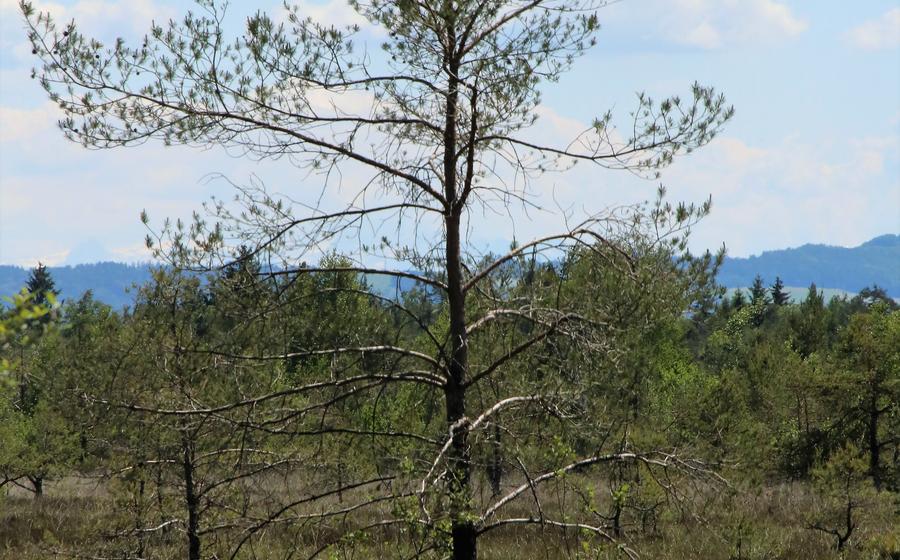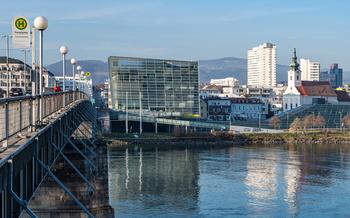
Ibmer Moor
- Ibmer Moor in a Nutshell
- Navigating the Maze
- Exploring the Moor's Unique Habitats
- Spotting Wildlife
- Unveiling the History of Peat Cutting
- Immersing in the Panoramic Views
- Discovering the Cultural Heritage
- Tips for Birdwatchers: Enhancing Your Experience
- Capturing the Essence of the Moor
- Ensuring a Safe and Enjoyable Visit
- Exploring the Moor with Kids
- Accessible Adventures
- Supporting Conservation Efforts
- Unforgettable Experiences
- Insider Tip: Unveiling the Moor's Nocturnal Wonders
Ibmer Moor in a Nutshell
In the heart of Upper Austria lies a natural treasure waiting to be explored – the vast expanse of Ibmer Moor, a raised bog of unparalleled beauty and ecological significance. Spanning an area of over 7,000 hectares, this unique wetland is a haven for biodiversity, providing a sanctuary for numerous endangered species and serving as a crucial stopover site for migratory birds. Step into this pristine wilderness and marvel at its diverse habitats, including open water, reed beds, and raised bogs, each teeming with specialized flora and fauna that have adapted to the moor's unique conditions. Experience the tranquility and serenity of this untouched ecosystem, where the only sounds are the calls of birds and the gentle rustling of the wind through the reeds. Prepare to be mesmerized by the Ibmer Moor's stunning natural beauty and discover the rich tapestry of life that thrives within its boundaries.
Navigating the Maze
Exploring the vast expanse of the Ibmer Moor requires careful planning and navigation. An extensive network of footpaths and trails crisscrosses the landscape, catering to hikers of all levels. Detailed maps and guidebooks are readily available, providing valuable insights into the moor's diverse habitats and points of interest. Guided tours led by local experts offer a unique opportunity to learn about the moor's history, ecology, and conservation efforts. Allow ample time to explore this vast wilderness, as the true beauty of the Ibmer Moor unfolds gradually, rewarding those who take the time to immerse themselves in its tranquil embrace.
Exploring the Moor's Unique Habitats
The Ibmer Moor is renowned for its diverse mosaic of habitats, each with its own distinct characteristics. Open water bodies, such as ponds and lakes, provide a sanctuary for various aquatic plants and animals. Reed beds, with their tall, swaying reeds, offer shelter and nesting sites for numerous bird species. Raised bogs, the most prominent feature of the moor, are characterized by their hummocky terrain and acidic peat soils. These hummocks and hollows create a unique microhabitat that supports specialized plants, such as sundews and bog asphodels, which have adapted to the harsh conditions.
As you wander through the moor, keep an eye out for the distinctive plant communities that thrive in each habitat. The open water bodies are home to water lilies, yellow irises, and various sedges. In the reed beds, you may spot reed buntings, marsh harriers, and the occasional bittern. The raised bogs, with their acidic and nutrient-poor conditions, support a unique array of plants, including carnivorous sundews, delicate bog orchids, and the iconic bog rosemary.
The Ibmer Moor is a haven for wildlife, and its diverse habitats provide shelter and sustenance for a wide range of species. Take the time to observe the intricate interactions between plants and animals, and marvel at the resilience of life in this unique and fragile ecosystem.
Spotting Wildlife
As you venture into the Ibmer Moor, keep your eyes peeled for the diverse array of wildlife that calls this unique habitat home. The moor is a haven for bird enthusiasts, with a variety of species that thrive in its mosaic of wetlands, grasslands, and woodlands.
Among the most iconic birds to spot are the black grouse, with their striking black plumage and distinctive tail feathers. Listen for their characteristic "kroo-kroo" call as they fly overhead or display their courtship rituals in the open fields.
Curlews, with their long, downcurved bills, are another common sight in the moor. Their haunting calls echo across the landscape, adding to the mystical ambiance of the place.
Lapwings, with their distinctive black-and-white plumage and crest, can be seen wheeling and diving over the moor, their cries adding to the symphony of bird sounds.
In addition to birds, the moor is home to a variety of other wildlife. Otters and beavers are known to inhabit the area, and their tracks can be spotted along the water's edge.
The marsh fritillary butterfly, a threatened species, thrives in the moor's unique habitat. Look for its bright orange wings fluttering among the wildflowers, a testament to the moor's ecological importance.
As you explore the moor, take the time to observe the specialized adaptations that plants and animals have developed to survive in this unique environment. The moor's wildlife is a testament to the resilience and beauty of nature, and each encounter is a chance to learn more about the wonders of the natural world.
Unveiling the History of Peat Cutting
In the heart of the Ibmer Moor lies a fascinating tale of human interaction with the natural world. Centuries ago, the moor played a pivotal role in the lives of the local communities, who relied on its peat reserves for fuel and building materials. Peat cutting was a laborious and challenging process that required skill, endurance, and a deep understanding of the moor's delicate ecosystem.
Peat cutters, known as "Torfstecher" in German, ventured into the depths of the moor, armed with specialized tools and a determination to extract the precious fuel. Using long-handled spades, they carefully cut blocks of peat from the surface, stacking them to dry in the sun and wind. The dried peat was then transported to nearby villages and towns, where it was used for heating and cooking.
The remnants of these past activities can still be seen scattered across the moor, where old peat cuttings and drainage ditches serve as a testament to the ingenuity and resourcefulness of the local people. These historical relics offer a glimpse into the challenges and hardships faced by the peat cutters, who worked tirelessly to provide for their communities.
Peat cutting played a crucial role in shaping the cultural heritage of the region. The peat industry not only provided livelihoods but also fostered a sense of community and resilience among the moorland inhabitants. Today, the Ibmer Moor stands as a reminder of this unique chapter in human history, where the lives of the people were intricately intertwined with the rhythms and resources of the natural world.
Immersing in the Panoramic Views
Ascend the observation tower, a prominent landmark that rises above the vast expanse of the Ibmer Moor. From this vantage point, breathtaking vistas unfold before your eyes, showcasing the true grandeur of this natural wonder. Marvel at the intricate tapestry of colors and textures that paint the landscape, from the vibrant greens of the reed beds to the deep browns of the peat bogs.
The panoramic views from the observation tower are not to be missed. On a clear day, you can see for miles in every direction, taking in the rolling hills, lush forests, and sparkling lakes that surround the moor. The tower also offers a unique perspective on the unique habitats that make up the moor, allowing you to appreciate the diversity of this extraordinary ecosystem.
Whether you choose to visit at sunrise, sunset, or any time in between, the Ibmer Moor will captivate you with its ever-changing beauty. As the sun rises, the moor glows with a warm golden light, casting long shadows across the landscape. As the sun sets, the sky transforms into a canvas of vibrant hues, painting the moor in shades of pink, orange, and purple.
Find a secluded spot to enjoy a picnic surrounded by nature's wonders. Pack a delicious lunch and a blanket, and settle down on a grassy knoll or by the edge of a tranquil pond. As you savor your meal, take in the sights and sounds of the moor, from the gentle rustling of the reeds to the melodious songs of birds.
Discovering the Cultural Heritage
Beyond its natural wonders, the Ibmer Moor region is steeped in a rich cultural heritage that awaits exploration. Immerse yourself in the charming village of Ibmer, a gateway to the moor's cultural treasures. Stroll through its quaint streets, admiring the traditional architecture and colorful facades that reflect the region's history. Visit the local museum to delve into the fascinating past of the area, showcasing exhibits that narrate the stories of its people, their traditions, and their connection to the moor.
Savor the authentic flavors of the region by indulging in the local cuisine. Sample hearty dishes prepared with fresh, locally sourced ingredients, often featuring specialties such as freshly caught fish from the moor's waterways or wild mushrooms foraged from the surrounding forests. Engage with the friendly locals, who are always eager to share their stories and insights into the unique way of life that has flourished in this region for generations.
Tips for Birdwatchers: Enhancing Your Experience
As a bird enthusiast, visiting the Ibmer Moor offers a chance to observe a diverse array of avian species in their natural habitat. To enhance your birdwatching experience, consider these tips:
-
Binoculars and Field Guide: Equip yourself with a good pair of binoculars and a comprehensive field guide to help you identify different bird species.
-
Timing is Key: Plan your visit for the early morning or late evening when bird activity is at its peak. Many birds are most active during these times, increasing your chances of spotting and identifying them.
-
Patience and Observation: Birdwatching requires patience and keen observation skills. Many birds are well-camouflaged and may be difficult to spot at first glance. Take your time to scan the landscape and listen for bird calls.
-
Guided Tours: Consider joining a guided birdwatching tour led by local experts. These tours provide valuable insights into the birdlife of the moor and can help you spot species that you might have missed on your own.
Capturing the Essence of the Moor
The Ibmer Moor, with its breathtaking landscapes, unique flora, and diverse wildlife, is a photographer's paradise. Whether you're a seasoned professional or an enthusiastic amateur, the moor offers countless opportunities to capture stunning images that will transport viewers to this magical realm.
Bring your camera along and prepare to be amazed by the kaleidoscope of colors and textures that unfold before your lens. From the vibrant hues of wildflowers to the intricate patterns of the raised bogs, every corner of the moor is a potential masterpiece waiting to be discovered.
To ensure sharp and steady shots, especially when photographing birds or other wildlife, use a tripod. Experiment with different angles and compositions to create dynamic and visually appealing images that showcase the moor's unique beauty.
After your visit, share your photos online or in print to inspire others to explore this natural treasure. Your images can help raise awareness about the importance of conservation and encourage others to protect and preserve this fragile ecosystem.
Ensuring a Safe and Enjoyable Visit
Venturing into the Ibmer Moor requires careful preparation and adherence to responsible practices to ensure a safe and enjoyable experience for all visitors. Begin by choosing suitable footwear, such as hiking boots or sturdy shoes, to navigate the uneven terrain and protect your feet from sharp objects. Be prepared for unpredictable weather conditions by packing rain gear and layers of clothing to adapt to changing temperatures.
Respect the fragile ecosystem by staying on designated trails to minimize your impact on the environment. Avoid venturing off the paths, as this can damage sensitive vegetation and disturb wildlife. Refrain from picking flowers or plants, as they play a crucial role in the moor's delicate balance. Additionally, please dispose of waste responsibly by carrying out all trash and avoiding littering.
Respect wildlife by observing them from a distance and refraining from disturbing their natural behavior. Avoid approaching animals too closely, as this can cause stress or even danger to both the animal and yourself. If you encounter wildlife, maintain a calm and respectful demeanor, allowing them to continue their activities undisturbed.
By following these guidelines, you can contribute to the preservation of the Ibmer Moor's natural beauty and ensure a safe and enjoyable experience for yourself and future visitors.
Exploring the Moor with Kids
Visiting the Ibmer Moor with children can be a fun and educational experience. To make the most of your family adventure, consider the following tips:
- Engage children in interactive activities: Encourage kids to learn about the moor's unique flora and fauna through interactive activities such as scavenger hunts or nature journaling.
- Choose family-friendly trails: Opt for trails that are suitable for all ages and abilities. Look for trails that offer interesting features such as boardwalks, observation platforms, or interactive exhibits.
- Bring snacks and drinks: Pack a variety of snacks and drinks to keep everyone energized throughout the hike.
- Teach children about conservation: Use the opportunity to teach children about the importance of conservation and protecting the environment. Discuss the role of the moor as a habitat for wildlife and the need to preserve its natural beauty.
Accessible Adventures
The Ibmer Moor is committed to ensuring that everyone has the opportunity to experience its natural wonders, regardless of their abilities. Wheelchair-friendly trails and viewing platforms have been meticulously designed to provide accessible routes through the diverse landscapes. For those who require additional support, assisted walking devices and all-terrain wheelchairs are available for rent, allowing visitors to navigate the uneven terrain with ease.
To ensure a smooth and enjoyable visit, it is advisable to contact local tourism organizations in advance. They can provide detailed information on accessible tours, facilities, and any special arrangements that may be required. With careful planning, individuals with disabilities can fully immerse themselves in the beauty of the Ibmer Moor, creating lasting memories in the heart of nature's embrace.
Supporting Conservation Efforts
The Ibmer Moor is a unique and fragile ecosystem that faces various threats, including habitat loss, pollution, and climate change. Several organizations are working tirelessly to protect and conserve this natural treasure for future generations. Visitors to the moor can contribute to these efforts in several ways.
Firstly, consider making a donation to organizations dedicated to the conservation of the moor. Your financial support can directly contribute to habitat restoration projects, species monitoring programs, and educational initiatives.
Secondly, volunteer your time to assist with conservation activities. Many organizations welcome volunteers to help with tasks such as planting trees, removing invasive species, and monitoring wildlife populations. Volunteering is a rewarding way to give back to the moor and make a hands-on impact.
Thirdly, spread awareness about the importance of the moor and encourage others to visit and support its conservation. Share your experiences, photos, and stories on social media, blogs, or travel forums. By raising awareness, you can inspire others to appreciate and protect this natural wonder.
Finally, choose sustainable travel practices that minimize your impact on the environment. Opt for public transportation or carpooling to reduce carbon emissions, and avoid littering or disturbing wildlife. By traveling responsibly, you can help preserve the pristine beauty of the Ibmer Moor for generations to come.
Supporting conservation efforts at the Ibmer Moor is not just about protecting a natural habitat; it is about preserving a unique and irreplaceable part of our planet's biodiversity. Every contribution, no matter how small, can make a difference in ensuring the long-term survival of this remarkable ecosystem.
Unforgettable Experiences
Visiting the Ibmer Moor is an experience that will stay with you long after you leave. The stunning landscapes, unique flora and fauna, and the tranquility of the untouched wilderness create a sense of wonder and awe. Whether you're a nature enthusiast, a birdwatcher, a photographer, or simply someone looking for a peaceful escape, the moor has something to offer everyone. Share your personal stories and experiences of visiting the Ibmer Moor with friends and family. Create a scrapbook or journal to document your adventures and memories. Return to the moor in different seasons to witness the changing landscapes and wildlife. Encourage others to explore this hidden gem and discover its unique beauty.
Insider Tip: Unveiling the Moor's Nocturnal Wonders
For a truly enchanting experience, venture into the Ibmer Moor during the ethereal glow of the early morning mist. As the sun peeks over the horizon, the moor transforms into a mystical realm where the air hangs heavy with moisture and the landscape shimmers with a soft, golden light. The mist creates an almost otherworldly atmosphere, muffling sounds and blurring the boundaries between reality and imagination.
As night falls, the moor takes on a new persona, alive with the sounds of nocturnal wildlife. The croaking of frogs, the hooting of owls, and the chirping of crickets create a symphony of nature that fills the air. Embark on a guided night walk to discover the moor's hidden secrets and spot elusive creatures that emerge under the cloak of darkness.
For a truly awe-inspiring experience, join a stargazing event organized by local astronomy clubs. As the night sky darkens, the stars come out in full force, painting a breathtaking celestial tapestry above the still waters of the moor. Lie back and marvel at the Milky Way, stretching across the heavens like a shimmering river of stars.
Capture the magic of the night sky with your camera, using a tripod to ensure sharp and steady shots. The combination of the starry sky and the tranquil waters of the moor creates a mesmerizing composition that will leave you in awe.









